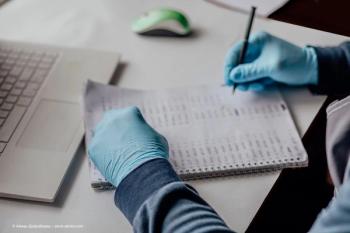
COVID-19 pandemic highlights the power of electronic health records
Electronic health records may be the future of practice management.
COVID-19 challenged us to quickly implement new models of patient care, new data analytics, and greater information sharing. Although electronic health records (EHRs) have had mixed reviews, with a lot of public emphasis on their limitations, the high-functioning systems at large institutions responded with the needed changes, including real-time data regarding epidemiology, and supported cross-departmental training efforts.
This end user perspective of EHR innovations suggests that EHRs have the power to support patient care during a crisis across all subspecialties, with a capacity to facilitate clinical decision-making and make rapid, widespread workflow change possible. Although EHRs have been touted for their utility in times of crisis ranging from natural disasters to civil wars,1 they have not necessarily been assessed for their ability to accommodate the rapid change necessary to facilitate decision-making in a health crisis.2
The Health Information Technology for Economic and Clinical Health Act of 2009 provided incentive for the deployment of EHRs with the aim of improving health care quality, safety, and efficiency. Coming on the heels of that massive expansion of EHRs in US health care, COVID-19 represents an unprecedented test of the flexibility and utility of EHRs, with the potential to reveal both benefits and insufficiencies.
The public health crisis has motivated rapid innovation of EHRs to meet needs related to data sharing, data analysis, care of patients with COVID-19, and care of those who could not be seen in traditional settings. At our institutions, a diverse team of health care and information systems professionals worked for weeks to adapt our EHRs to better support patient care.
Although the severity of COVID-19 infection in some patients drew attention to inpatient medicine, the crisis profoundly affected ambulatory care. Similarly, the EHR affected the ability of ambulatory care to react to the crisis.
In this perspective, we provide an end user perspective on the utility of the EHR during the COVID-19 crisis. By looking at a diverse category of changes made by central medical information teams and applied across disciplines—including care updates, telehealth, results tracking, patient communications, and data analysis—we may see how a high-functioning, shared EHR is capable of accommodating rapid change. We also reveal how in certain instances, such innovation may be limited by the need for specialty-specific commitment to innovation of diagnostic tools and treatment modalities to take advantage of EHRs.
The first EHR changes that end users saw were focused on testing for COVID-19. Development of new order sets for COVID-19 testing proved integral in both inpatient and emergency department (ED) settings, with unique admission, discharge, and testing order sets. The EHR allowed new order sets for COVID-19 testing to be implemented quickly and then accommodated frequent changes as the situation evolved. As an example, COVID-19 testing was initially coupled with influenza testing but later decoupled as the prevalence of influenza waned in the population. Rapid changes in guidance regarding which patients should be tested were rapidly represented within the EHR.
Results tracking tools made available to end users included mechanisms for immediate release of COVID-19 test results to both patients and providers, addition of diagnosis records searchable by the string SARS-CoV-2 to help identify specific manifestations of the COVID-19 illness (eg, gastroenteritis due to COVID-19 virus), and unique in-basket filters for COVID-19 and respiratory tests to help triage results.
New summary reports were developed to assist providers in understanding a patient’s COVID-19–related information via quick-access buttons. Finally, a diverse set of automated and standardized documentation phrases were developed ranging from COVID-19 screening questions in the ED to COVID-19 testing information to notes from COVID-19–related encounters. These proved essential in standardizing documentation both on the front lines in the ED and across a variety of subspecialties that had to quickly adapt to a novel form of health care delivery. With broad access to these results, care in all environments was made safer.
Patient communication
Updates to patient communication proved essential in managing the surge of patient messages and calls. Documentation tools were created with templates to help draft patient education materials, patient-initiated secure messages, and COVID-19–related visits. In ambulatory care, the EHR facilitated care communication around rescheduling, enabling a massive effort involving tens of thousands of patients and ensuring they were not lost to follow-up or delayed in getting care. Providers were able to review charts remotely, determine the urgency of rescheduled patients, and route triage messages to staff.
Patient instructions were rapidly developed and deployed, with constant updates and revisions on topics ranging from how to use telemedicine technology to information about COVID-19 (signs, symptoms, prevention) to new clinic procedures designed to ensure patient and staff safety.
Data sharing
Clinical informaticists and EHR analysts developed and deployed tools supporting the ability to share information related to COVID-19 with end user clinicians. COVID-19 summary reports allowed users to quickly review patient data without entering patient charts. Enterprise-wide dashboards displayed the numbers of patients being tested, testing positive for COVID-19, and being admitted to the hospital.
Centralized EHR teams and research analysts were able to study demographic data and identify characteristics that were associated with a high risk of complications. At times, this enabled conversation about timeliness of rescheduling during the “shut-down” period.
All ambulatory appointments were triaged centrally before the appointment with rapid status updates placed into the EHR, and triage calls were performed by a third-party vendor, CipherHealth. All care providers, inpatient and ambulatory, received notification of patients who failed the triage screen, prompting further assessment before the patient arrived at the office and thereby reducing the risk of exposure to the virus.
Shift to telemedicine
COVID-19 drove a rapid shift to telemedicine, facilitated by modified regulatory and payment restrictions on synchronous telehealth. Telemedicine virtual switchboards were developed to facilitate easier video visit delivery and better ensure patient privacy (by preventing patients from accidentally joining other patients’ video visits). New documentation tools and workflow rules were deployed and frequently updated to ensure that providers were following the latest rules and regulations as they were released by payers. Text expansion phrases and dot phrases for verbal consents, as well as tools for patient consent documentation, were integrated to accommodate the new virtual visits.
Initial changes made available to end users were diverse, ranging from result tracking to order sets to documentation tools (long phrases, templates) to telemedicine platforms and technologies. These changes were all meant to facilitate and improve the user experience; the billing capture and process; the integration of outcomes, administrative, and research activities; and information flow.
Limitations
Despite the extensive support of the EHR system, some specialties clearly required more than virtual platforms and communication tools. Furthermore, institutions themselves differed in their ability to take full advantage of the EHR platform to deliver telehealth. At Penn, the rheumatology and ear, nose, and throat departments demonstrated great utilization of telehealth platforms, with up to 59% and 75% of total visits, respectively, conducted virtually.
Family Medicine and Internal Medicine at Penn were able to boost telemedicine visits from 0% to 30% of total encounters. At Johns Hopkins, Family Medicine, Internal Medicine, and Dermatology were able to achieve a virtual visit volume of 90% of total encounters with the help of EHR support. Emergency payment models reflected the change in the payer perspective of telehealth and made it financially feasible. Continual advances in EHR innovation, however, made telemedicine possible at all.
For certain specialties, the impact of EHR progress was more limited, not clearly explained by changes in reimbursement or EHR implementation. Ophthalmology demonstrated consistently low telemedicine utilization across institutions even during the height of the pandemic and dropped from up to 7% of total visit volume to 1% to 2% as COVID-19 restrictions started to lift. Although the EHR had the capacity to be the vehicle of innovation, specialties such as ophthalmology needed further innovation in diagnostic tools and testing to realize the full power of the remote visits.
Conclusions
The volume of data made available by EHRs and the ability to customize them to accommodate different workflows can represent either a huge challenge or a huge opportunity for a health care organization. Regarding COVID-19, we believe our institutions fell into the latter category. We found the EHR infrastructure (and all the teams who support it) essential to the survival of the health system and the safety of patients and providers.
COVID-19 challenged the health care system to implement new models of patient care, new data analytics, and greater information sharing. The reputation of the EHR as cumbersome and inefficient is perhaps undeserved. The high-functioning systems and teams at our institutions responded with the needed changes, including real-time epidemiologic data, improvements in information sharing, and support of new workflows.
Based on this end user experience, we believe EHRs have the power to support patient care during a crisis across all subspecialties, with a capacity to facilitate clinical decision-making and make rapid, widespread workflow change possible. Although the EHR has the capacity to be the vehicle of innovation, it must be matched by dedicated innovation in diagnostic tools to enable all specialties to capitalize on the advances it supports.
References
1. Williams F, Boren S. The role of electronic medical record (EHR) in care delivery development in developing countries: a systematic review. Inform Prim Care. 2008;16(2):139-145. doi:10.14236/jhi.v16i2.685
2. Steiner DJ, Coyle JF, Rocha BH, Haug PJ, Huff SM. Medical data abstractionism: fitting an EHR to radically evolving medical information systems. Medinfo. 2004:550-554.
Newsletter
Keep your retina practice on the forefront—subscribe for expert analysis and emerging trends in retinal disease management.
















































